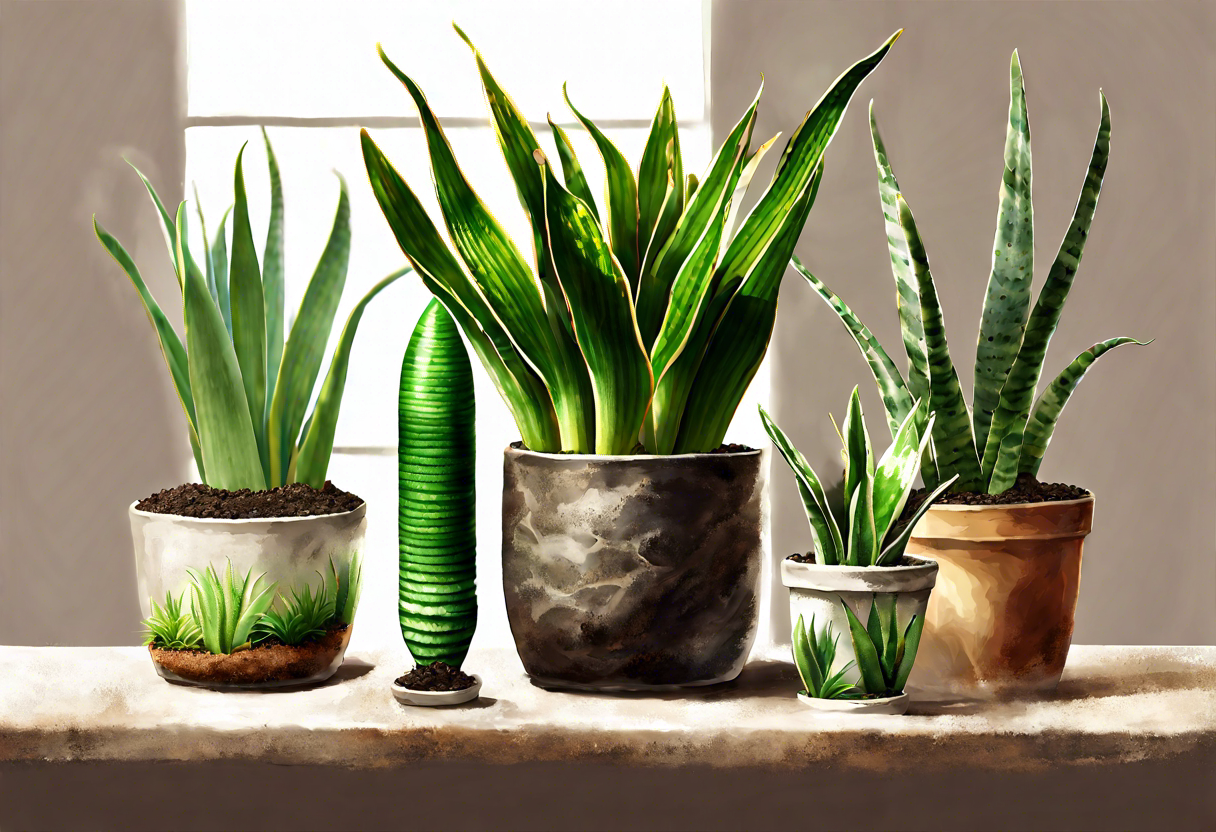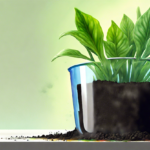Benefits of Using the Best Soil or Potting Mix for Snake Plant Growth
When it comes to growing a snake plant (Sansevieria), choosing the right soil or potting mix is crucial for its overall health and well-being. The best soil or potting mix will provide the necessary nutrients and drainage for optimum growth. Here are some benefits of using the best soil or potting mix for snake plant growth:
-
Enhanced Drainage: Snake plants prefer well-draining soil that prevents waterlogging, as excessive moisture can lead to root rot. The best soil or potting mix for snake plants usually contains a combination of materials like perlite, vermiculite, or coarse sand, which help improve drainage. This allows excess water to pass through and ensures the roots are not sitting in overly moist conditions.
-
Improved Aeration: Snake plants thrive in soil that is well-aerated. The best soil or potting mix for snake plants has a light and airy texture that allows oxygen to reach the roots. This is particularly important because snake plants are susceptible to root suffocation if the soil is too compact. Including organic matter such as compost or peat moss in the potting mix can help improve aeration.
-
Nutrient Availability: The best soil or potting mix for snake plants provides essential nutrients for healthy growth. The mix should be rich in organic matter, such as well-decomposed compost or aged manure, which acts as a natural fertilizer. Additionally, incorporating slow-release granular fertilizers specific to snake plants can help ensure a consistent supply of nutrients over time.
-
Disease Prevention: Using the best soil or potting mix can help prevent disease in snake plants. Well-draining soil reduces the likelihood of root rot, which is a common problem when the soil retains too much moisture. Additionally, using clean, sterile soil or potting mix can minimize the risk of introducing pests or fungal pathogens to the plant.
-
Optimum Root Development: Snake plants have a unique root system known as rhizomes, which allows them to store water and nutrients. The best soil or potting mix allows for proper root development and encourages the growth of healthy rhizomes. A well-draining mix prevents root overcrowding and supports the formation of new rhizomes, promoting overall plant vigor.
Choosing the best soil or potting mix for snake plants is essential for their growth and well-being. By providing efficient drainage, improved aeration, essential nutrients, disease prevention, and optimum root development, the right soil or potting mix can help ensure your snake plant thrives in its environment. Remember to repot your snake plant every few years using the best soil or potting mix to maintain its health and longevity.
Factors to Consider When Choosing the Best Soil or Potting Mix for Snake Plants
When it comes to the best soil or potting mix for snake plants (Sansevieria), there are several factors to consider. These factors will help provide the ideal growing conditions for your snake plant and ensure its long-term health and vitality.
First and foremost, drainage is a critical factor to keep in mind. Snake plants do not thrive in waterlogged conditions, so it is essential to choose a well-draining soil or potting mix. Look for a mix that contains ingredients such as perlite, gravel, or sand, which promote proper water drainage and prevent root rot. It is important to avoid heavy soils that retain water for extended periods.
Another important consideration is the ability of the soil or potting mix to retain moisture. While it is crucial to have well-draining soil, snake plants also require some moisture to thrive. Look for a mix that strikes the right balance between drainage and moisture retention. A good option is to choose a mix that contains components like peat moss or coconut coir, which help retain moisture while still allowing excess water to drain away.
The pH level of the soil is also important when selecting the best soil or potting mix for snake plants. Snake plants prefer a slightly acidic to neutral pH, ranging from 6.0 to 7.0. It is beneficial to choose a soil or mix that falls within this range to provide an optimal growing environment for your snake plant.
Furthermore, the texture of the soil is worth considering. Snake plants thrive in loose and well-aerated soil. A mix that is too compact will prevent proper airflow and hinder root growth. Look for a soil or potting mix that is light and well-textured, allowing air to circulate freely around the roots.
It is worth considering organic options when choosing the best soil or potting mix for snake plants. Organic mixes are free from synthetic chemicals and fertilizers, making them a safer option for both you and your plants. Additionally, organic mixes often contain beneficial microorganisms that promote healthy soil and plant growth.
Choosing the best soil or potting mix for snake plants involves considering factors such as drainage, moisture retention, pH level, texture, and organic options. By selecting a mix that meets these criteria, you can provide the ideal growing conditions for your snake plant and ensure its long-term health and vitality. Remember to check your plant’s specific needs and adjust your soil or potting mix accordingly.
Choosing the Best Soil or Potting Mix for Snake Plants
When it comes to keeping your snake plants (Sansevieria) healthy and thriving, choosing the right soil or potting mix is crucial. Snake plants are known for their adaptability and resilience, but they still have specific soil requirements to ensure optimal growth. In this article, we will explore the different types of soil or potting mix suitable for snake plants and provide you with some valuable tips on selecting the best one.
One of the key factors to consider when choosing a soil or potting mix for snake plants is its ability to provide adequate drainage. Snake plants dislike sitting in overly moist soil, as it can lead to root rot and other fungal diseases. Therefore, it is essential to select a well-draining soil mix to prevent waterlogging.
A popular option for snake plants is a loose and well-aerated mix that consists of equal parts of peat moss, perlite, and coarse sand. This blend allows excess water to drain away quickly, while the peat moss retains enough moisture for the plant’s roots.
Another suitable soil or potting mix for snake plants is a succulent or cactus mix. These mixes are specifically formulated to provide excellent drainage and are made up of materials like coarse sand, pumice, perlite, and a small amount of organic matter. The added perlite and organic matter help improve water retention without compromising drainage, creating a balanced environment for snake plant roots to thrive.
If you prefer a more DIY approach, you can create your own soil mix for snake plants. A recommended recipe includes equal parts of coco coir, perlite, and fine bark or orchid bark. This combination offers good drainage, moisture retention, and aeration.
When repotting your snake plant, it is essential to choose a potting mix that is appropriate for the size of the plant. Young snake plants require a lighter mix to promote root development, while more mature plants can benefit from a slightly heavier mix that provides stability.
Choosing the best soil or potting mix for snake plants involves considering their specific needs for proper drainage and moisture retention. Whether you opt for a commercial succulent mix or create your blend, ensuring a well-aerated and well-draining environment for your snake plant will help it grow and thrive. By selecting the right soil mix and repotting when necessary, you can enjoy a flourishing snake plant that adds beauty and purifies the air in your home or office.
Guide to Repotting Snake Plants Using the Best Soil or Potting Mix
Repotting snake plants is a crucial task that helps promote their growth and overall health. By providing them with the best soil or potting mix, you can ensure that they thrive in their new environment. Here is a step-by-step guide to repotting snake plants using the best soil or potting mix:
1. Choose the right time: Repotting snake plants should ideally be done in spring or summer when they are actively growing. This allows them to recover quickly from any stress caused by the repotting process.
2. Select a suitable container: Choose a pot that is slightly larger than the current one, allowing room for the plant to grow. Ensure that the new pot has drainage holes to prevent waterlogging, which can lead to root rot.
3. Prepare the potting mix: The best soil or potting mix for snake plants should be well-draining to prevent waterlogged roots. A recommended mix consists of equal parts of succulent potting soil, perlite, and coarse sand. This mix provides excellent drainage while retaining enough moisture for the plant’s needs.
4. Remove the plant from its current pot: Gently tap the pot’s sides to loosen the soil and carefully remove the snake plant from its current container. Be cautious not to damage the roots during this process.
5. Inspect the roots: Once the snake plant is out of its pot, inspect the roots for any signs of rot or pest infestation. Trim any damaged or diseased roots using clean pruning shears.
6. Add the new potting mix: Place a layer of the prepared potting mix at the bottom of the new pot. Position the snake plant in the center and fill the remaining space with the mix, ensuring that the roots are adequately covered. Gently press the soil around the plant, securing it in place.
7. Water the newly potted plant: After repotting, water the snake plant thoroughly until the water drains from the pot’s bottom. This helps settle the soil around the roots and minimizes air pockets.
8. Allow for acclimation: Place the repotted snake plant in a bright area with indirect sunlight. Avoid exposing it to direct sunlight, as this can lead to sunburn. Let the plant acclimate to its new pot and environment for a few weeks.
9. Maintain proper care: Once the snake plant is repotted, ensure that it receives the right care. Water the plant only when the top inch of the soil feels dry, as overwatering can cause root rot. Provide moderate sunlight, and avoid placing it in drafty areas.
By following this step-by-step guide to repotting snake plants using the best soil or potting mix, you can provide them with optimal conditions for growth. Remember to choose the right time, select a suitable container, prepare the potting mix, and follow proper watering and care routines. Your snake plants will reward you with their vibrant foliage and improved health.
How to Maintain Healthy Snake Plants with the Right Soil or Potting Mix: Tips and Tricks
Snake plants (Sansevieria) are popular houseplants known for their durability and ability to thrive in various conditions. One essential factor in keeping these plants healthy is using the best soil or potting mix. The right soil not only provides proper drainage but also supplies essential nutrients for optimal growth. Here are some tips and tricks for maintaining healthy snake plants with the right soil or potting mix.
Firstly, it’s crucial to choose a well-draining soil or potting mix for snake plants. These plants prefer slightly dry conditions and are prone to root rot if overwatered. A good soil mix consists of a combination of organic matter, such as peat moss or compost, and inorganic materials like perlite or coarse sand. This blend ensures that excess moisture drains out, preventing waterlogged roots.
Another factor to consider is the pH level of the soil. Snake plants thrive in slightly acidic to neutral soil, with a pH range of 6.0 to 7.0. Testing the pH level of your soil can help you determine if it needs any adjustments. If the soil is too acidic, you can add lime to raise the pH, and if it’s too alkaline, sulfur can be incorporated to lower it. Maintaining the optimal pH level helps the snake plant absorb nutrients efficiently.
When repotting snake plants, choose a pot that has drainage holes to prevent water from pooling at the bottom. Using a pot with a well-draining soil mix facilitates better airflow to the roots and reduces the risk of overwatering. It’s recommended to repot snake plants every two to three years to provide fresh soil and encourage healthy growth.
Fertilizing snake plants is essential, but moderation is key. These plants are known for their low nutrient requirements, and excessive fertilization can lead to burning or scorching of the leaves. Use a balanced, slow-release fertilizer or a diluted liquid fertilizer to provide the necessary nutrients without overwhelming the plant. During the growing season, fertilize snake plants once a month or as directed on the fertilizer packaging.
In addition to the proper soil and fertilization, snake plants also benefit from sufficient sunlight. Place them in bright, indirect light for best results. However, snake plants can tolerate low light conditions, making them ideal for various indoor environments. Avoid exposing them to direct sunlight, as it can cause leaf burning.
Maintaining healthy snake plants requires the right soil or potting mix. Opt for a well-draining blend of organic and inorganic materials, ensuring proper airflow and preventing waterlogged roots. Consider the pH level of the soil, keeping it slightly acidic to neutral, and choose pots with drainage holes for repotting. Fertilize the plants in moderation using a balanced fertilizer, and provide them with adequate sunlight. Following these tips and tricks will help you keep your snake plants thriving and beautiful.
Conclusion
Snake plants, also known as Sansevieria, are popular houseplants thanks to their striking beauty and low-maintenance nature. However, to ensure their optimal growth and health, it is crucial to provide them with the best soil or potting mix. By using the appropriate soil composition, snake plants can thrive and bring beauty and a touch of nature to any indoor space.
When choosing the best soil or potting mix for snake plants, several factors need to be considered. First and foremost is the porosity of the soil. Snake plants prefer a well-draining soil that allows excess water to escape readily, preventing root rot and overwatering. Opting for a mix that includes perlite, vermiculite, or coarse sand can promote good drainage.
Another important aspect to consider is the level of acidity in the soil. Snake plants thrive in slightly acidic to neutral pH levels. Therefore, a potting mix with a slightly acidic pH of around 6 to 7 is ideal. This pH range ensures that the plant can effectively absorb nutrients from the soil and maintain its overall health.
Various types of soil or potting mix can be suitable for snake plants. A blend of peat moss, perlite, and regular potting soil is a popular choice. The peat moss provides moisture retention, while perlite improves drainage. Additionally, cactus soil mixed with perlite can also be a good option, as it replicates the well-drained conditions snake plants prefer.
Repotting snake plants using the best soil or potting mix is a simple process that can significantly benefit the plant’s growth. Begin by choosing a pot that is slightly larger than the previous one, allowing the roots to spread comfortably. Gently remove the plant from its old pot, being cautious not to damage the roots. Place the snake plant in the new pot, making sure the soil level remains consistent. Fill the pot with the selected potting mix, pressing it gently to eliminate any air pockets. Water the plant thoroughly, allowing any excess water to drain away.
To maintain healthy snake plants and ensure continued growth, it is important to follow a few tips. Firstly, avoid overwatering as snake plants are prone to root rot. Allow the top inch of soil to dry out before watering again. Additionally, providing adequate light is crucial for snake plants. They thrive in indirect sunlight, so placing them near a window with filtered light is ideal. fertilize the plants every two to three months during the growing season, using a balanced liquid fertilizer diluted to half strength.
Using the best soil or potting mix for snake plants offers numerous benefits, from improved drainage to optimal nutrient absorption. By considering factors such as porosity and acidity, selecting the right type of soil becomes easier. Following a step-by-step guide for repotting and incorporating maintenance tips, snake plants can thrive and bring beauty to any space. With the proper care and attention, snake plants can be a delightful addition to any indoor garden, adding a touch of nature and elegance to your home or office environment.



